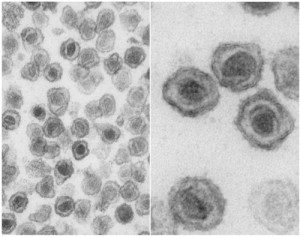

The article begins with a description of how XMRV DNA was isolated from surgically removed prostate tumor tissue. Sequence analysis of three strains showed that the virus is most closely related to xenotropic and polytropic murine leukemia viruses and hence was named xenotropic murine leukemia virus-related virus, or XMRV. Five lines of evidence indicate that XMRV is not a laboratory contaminant:
- XMRV was detected in RNA isolated from human prostate tissue
- Mouse sequences were not detected in the human prostate tissues
- Infections were mainly found in tissues from humans with an alteration in the protein RNAse L
- Slightly different viral sequences (polymorphisms) were identified in isolates from different patients
- Both viral RNA and viral proteins were detected in prostate tissues
The article continues with a summary of subsequent studies in which XMRV has or has not been detected in prostate cancer, then moves to the role of XMRV in CFS. Silverman concludes that “the scientific literature shows that XMRV was detected in the majority, but not all, prostate cancer studies, albeit at different rates, while XMRV was found in CFS in only one study of four published to date.” He offers the the following explanations for the difference in detection of XMRV in prostate cancer and CFS:
- Viral contamination from mouse sources. This cannot explain all positive findings in different laboratories using different experimental techniques.
- Geographical differences in the distribution of XMRV could account for some of the differences.
- Sequence differences could lead to failure to detect viral DNA by polymerase chain reaction.
- There are no standardized, sensitive methods of detection, and no widely available positive control samples.
The remainder of the article entails speculation on how XMRV might cause prostate cancer; the likely origin of the virus from a rodent virus; and antiviral drugs that are known to inhibit replication of the virus. It ends with the suggestion to test for the presence of XMRV in porcine tissues used for human transplantation, and in the blood supply, to avoid additional infections.
Silverman concludes:
Although other retroviruses of the same genus as XMRV (gammaretroviruses) cause cancer and neurological disease in animals, whether XMRV is a cause of either prostate cancer or CFS remains unknown.
Robert H. Silverman, Carvell Nguyen, Christopher J. Weight & Eric A. Klein. The human retrovirus XMRV in prostate cancer and chronic fatigue syndrome. Nature Reviews Urology doi: 10.1038/nrurol.2010.77.

Pingback: General Insurance » Blog Archive » Walking together to fight breast cancer
Thanks for this clear and concise summary!
XMRV was also found by another lab in Germany from samples taken in individuals respiratory tract. http://www.cdc.gov/eid/content/16/6/1000.htm
Interestingly enough many years ago “Crimson Crescents” were found in CFS patients throats in 1992 http://www.annals.org/content/116/4/347.2.extract
At the time the author also noted that he also found the distinctive marks in approx. 3-5% of healthy controls which falls within the range of XMRV found by the German and WPI study in healthy individuals.
Pingback: Resources | Prostate cancer Blog
I have Chronic Fatigue, hope one day it will be cured.
This isn't chronic fatigue – this is feeling VERY ILL!!!!!
Thanks for the article vincent.
Here's my question- what exactly do the negative studies tell us? At the recent 2010 CROI in San Francisco, the Emory researchers reported infecting monkeys with XMRV and then killing the monkeys to find out where the virus went. They found it in several different tissue types(I don't want to use 'extensive' or even 'widespread' to describe the infection; I don't know enough about it and don't want to weasel-word my description a la 'significant' findings in research where statistical significance is often misused to imply clinical significance), yet were unable to detect XMRV in plasma by standard PCR at any point in time.
Pingback: XMRV prompts media thought: ask for the “state of play†| Code for Life
“Well , the coach outlet view of coach handbags the passage is totally correct ,your details is really reasonable and you guy give us valuable informative post, I totally agree the standpoint of upstairs. I often surfing on this forum when I m free and I find there are so much good information we can learn in this forum!
ugg classic tall stripe cable knit boots
Pingback: PMRV joins XMRV as possible etiologic agent of chronic fatigue syndrome
Pingback: Is XMRV a laboratory contaminant?